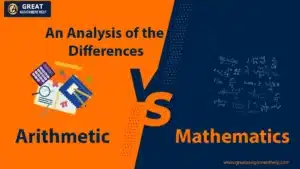People often confuse arithmetic with mathematics. However, they are not similar. Mathematics has a wider scope. It deals with the measurements and properties of quantities through numbers and symbols. In contrast, the scope of arithmetic is comparatively limited. It is a branch of mathematics that involves calculations with numbers. These are just the basic distinctions between arithmetic vs. mathematics. If you are intrigued to How to Learn Math Faster more about the differences, read this blog. Here, we have conducted a comprehensive study.
A Comparative Study of the Differences between Arithmetic vs. Mathematics
Following are the differences between Arithmetic vs. Java.
Arithmetic vs. Mathematics: Concept

Here is the difference in concept between Matlab vs. Mathematica:
- What is Arithmetic?
Arithmetic is one of the foundational branches of mathematics. It is the science of numbers, their properties, and relations. This mathematical section has a close connection to other mathematical branches like algebra and number theory. Primarily, arithmetic deals with the traditional operations of numbers. These functions include counting addition, subtraction, multiplication, division, exponentiation, and extraction of roots.
- What is Mathematics?
Mathematics is the area of knowledge concerned with numbers, formulas, connected structures, shapes and the spaces in which they are enclosed, and quantities and their changes. Number theory, algebra, geometry, trigonometry, and other sub-disciplines of mathematics represent these components. Mathematical activities primarily involve discovering the features of abstract objects called axioms and using deductive rules to prove various theorems.
This subject is essential to the studies of natural science, engineering, medicine, finance, computer science, and the social sciences. Learning mathematics helps students develop problem-solving and logical thinking skills.
Arithmetic vs. Mathematics: History
Arithmetic and Mathematics share a different history. Here is the difference between them:
- History of arithmetic
Arithmetic started its journey at the time human beings started counting. The practical need to count and calculate objects and make elementary measurements led to the emergence of arithmetic. The earliest record of arithmetic knowledge is found in various historical monuments in Babylon and Egypt that were built in the third and second millennia BC.
The Greek mathematician Pythagoras made a significant contribution to the growth of mathematics. He tried to define all things that happen frequently in the world in terms of numbers. Between the late 5th and 15th centuries, arithmetic expanded in the section of trade and approximate calculations. It continued to develop first in India and then in Islamic and Western European countries.
In the 17th century, new arithmetic developed further to meet the needs of astronomy, mechanics, and other commercial calculations. Numbers were theoretically justified in the year 1889 with the formulation of the definitions of natural numbers and Peano’s axioms. After that, rational, real, and complex numbers were developed.
- History of mathematics
The history of mathematics is concerned with the discovery and development of mathematics and mathematical notations. The written records and notations of mathematics texts date back to 2000 BC; for example, Plimpton was written in 2000 BC, the Rhind Mathematical Papyrus in 1800 BC, and the Moscow Mathematical Papyrus in 1890 BC. During that time, the people of Mesopotamia, Sumer, Akkad, and Assyria started using mathematics. The ancient Egyptians and Lebanese were the first users of mathematics. The earliest mathematics concepts like arithmetic, algebra, and geometry were used for taxation, commerce, and trade. Apart from that, mathematics helped in understanding the patterns of nature and in astronomy to note time and develop calendars.
However, Pythagoreans coined the term “mathematics in the 6th century BC. The Greeks expanded mathematics and refined its methods by introducing deductive reasoning and mathematical rigor. They did not contribute to the development of mathematical theories, but the Romans used applied mathematics for several purposes, including surveying, structural and mechanical engineering, bookkeeping, etc. The Chinese were the first to use negative numbers and introduce the place value system. However, the rules of mathematical operation and the Hindu-Arabic numeral system that we use today evolved during the first millennium AD in India. It later traveled to Western countries through the Middle Eastern parts of the world.
Also read: Importance of Math in Our Daily Life
Arithmetic vs. Mathematics: Branches
The branches of arithmetic contrast with those of mathematics. Following are their differences:
- Branches of arithmetic
There are 4 branches of arithmetic. It includes:
v Addition
Addition is one of the fundamental sections and operations of arithmetic. It combines 2 or more values to form a single term. Here are a few common examples:
1+1 =2
11+11 = 22
111+111= 222
Here, + is the operational symbol of addition.
However, there are a few exceptions. For example:
- Any element added to 0 gives the same number as a result, like 2+0 = 2.
- Adding inverse elements will give 0 as the result, like 3+(-3) = 0.
v Subtraction (−)
Subtraction is the opposite of addition. Here, the computation of two numbers, the minuend and the subtrahend, gives the difference in value. It is signified by the operator sign (-). If the minuend has a greater value than that of the subtrahend, the value of the resultant number is positive. However, if the subtrahend is larger than that of the minuend, then the resultant number has a negative value. It becomes 0 when the numbers are equal.
For example,
- 5 -, 3 = 2
- 3–5 = -2
- 5 – 5 = 0
v Multiplication (×)
In literal terms, multiplication means the repeated addition of a group of equal-sized numbers. It also merges two values to get a single product. The values are known as multiplicand and multiplier, or simply factors. Here, the product of two numbers a and b is written as a × b or through an asterisk,* when typed on the keyboard. The ‘×’ or ‘*’ are the operational symbols for multiplication.
For example,
- 4 × 4 = 14
- 2 × 8 = 16
v Division (÷)
Division is the opposite of multiplication. It breaks down a number into equal parts and finds how many equal divisions can be made. A division has 4 components:
- A divisor divides a number
- The dividend is the number that gets divided
- The quotient is the number obtained after dividing the number
- The remainder is the value that remains after the division
The operational symbol for division is ‘÷’ or ‘/’if performed manually. However, for typing on the keyboard, ‘/’ is mainly used.
For example,
- 10 ÷ 2 = 5
- 9 ÷ 3 = 3
- Branches of mathematics
Mathematics has many branches. The most common of them are the following:
v Algebra
Algebra solves intricate generic and non-generic expressions by maneuvering them through complicated formulas and rules to produce an answer. The quantities in the said equation have some values expressed through numbers, while others are kept unknown for the solvers of the expression. Therefore, they are mentioned in various English and Greek lexicons like ‘a’, ‘x’, ‘b’, or ‘c’. People need to manipulate the known values of the equation to discover the unknown values and come up with an answer.
Example:
Problem: 3x + 5 = 14
Solution:
3x = 14-5
3x = 9
x = 3.
v Number theory
Number theory is one of the oldest branches. It deals with the following:
- Recognizes the features of numbers like addition, subtraction, multiplication, and division, which further diverge from the associative and dissociative properties
- Develops a connection between real numbers, integers, whole numbers, and natural numbers
- Studies the concepts of encryption, binary, cryptography, game theory, etc
Example:
Problem:
Write the first 10 non-zero multiples of 3.
Solution:
A multiple of a value is the result acquired when two values merge.
The first 10 non-zero multiples of 3 are as follows:
3× 1 = 3
3 × 2 = 6
3 × 3 = 9
3 × 4 = 12
3 × 5 = 15
3 × 6 = 18
3 × 7 = 21
3 × 8 = 24
3 × 9 = 27
3 × 10 = 30
Hence, the first 10 non-zero multiples of 3 are 3, 6, 9, 12, 15, 18, 21, 24, 27, and 30.
v Arithmetic
Arithmetic is one of the fundamental branches of mathematics. It deals with numbers and their use in calculations. It studies the concepts of limits, exponents, etc. Plus, features like addition, subtraction, multiplication, and division are involved here.
Example:
Problem:
Find the value of 89 ÷ 83
Solution
89 ÷ 83 = 89/83
89-3
86
v Geometry
Geometry is an intricate subject and one of the oldest branches of mathematics. It deals with shapes, circles, rectangles, triangles, angles, and volumes. The subject also studies the spatial relationships between various objects and the features of the surrounding space. Apart from studying flat and three-dimensional spaces, geometry is also used to represent many abstract thoughts and images.
Example:
Problem:
The length of a rectangular box is 3 inches longer than its breadth. The area of the box is 40 square inches. What is the perimeter of the box?
Solution:
The following information is provided in the question:
Area = 40 square inches.
Let the length be called “l” and the breadth of the box be called “b.”
According to the question,
b = b, and l = 3+b
The geometric formula for the area of a rectangle is length × breath.
Therefore, 40 = (3+b)b
40 = 3b +b2
This can be noted as b2+3b-40 = 0.
On factoring the equation b2+3b-40 = 0, the following information is available:
b = 5, and b = -8.
Since the value of length cannot be negative, b = 5 inches.
By putting the value of b = 5 in l = 3 + b, the following results can be obtained:
l = 3 + 5 = 8 inches.
The formula for the geometric perimeter of a rectangle is 2(l+b) units.
P = 2 (8 + 5)
P = 2 (13) = 26.
Thus, the perimeter of a rectangle is 26 inches.
Read More: Learn How To Effectively Study For A Math Test
Arithmetic vs. Mathematics: Real-Life Uses
The uses of arithmetic are limited as compared to mathematics on the whole. Here is the disparity between their implications in practical-life situations.
- Arithmetic: Basic calculations of arithmetic like addition, multiplication, subtraction, and division are used for multiple purposes, for example, watching time on the clock, paying money, making transactions, cooking, etc.
- Mathematics: Mathematics is used for a variety of purposes. Common examples include balancing checkbooks, determining the distance and cost of travel, taking and lending loans, playing sports, etc.
Tabular Representation of the Differences between Arithmetic vs. Mathematics
| Basis of Difference | Arithmetic | Difference |
| Concept | Arithmetic is one of the foundational branches of mathematics. It is the science of numbers, their properties, and relations. This mathematical section has a close connection to other mathematical branches like algebra and number theory. Primarily, arithmetic deals with the traditional operations of numbers. These functions include counting addition, subtraction, multiplication, division, exponentiation, and extraction of roots.
|
Mathematics is the area of knowledge concerned with numbers, formulas, connected structures, shapes and the spaces in which they are enclosed, and quantities and their changes. Number theory, algebra, geometry, trigonometry, and other subdisciplines of mathematics represent these components. Mathematical activities primarily involve discovering the features of abstract objects called axioms and using deductive rules to prove various theorems.
|
| Branches | Arithmetic has 4 primary branches. It includes addition, subtraction, multiplication, and division. | There are many branches of mathematics. The most common of them are algebra, number theory, arithmetic, and geometry. |
| Uses | Arithmetic has limited uses compared to mathematics. Basic arithmetic calculations like addition, multiplication, subtraction, and division are used for multiple purposes, for example, watching time on the clock, paying money, making transactions, cooking, etc. | Mathematics has wider uses. Common examples of mathematics are balancing checkbooks, determining the distance and cost of travel, taking and lending loans, playing sports, etc. |
Also read: Best Math Research Topics for Students to Consider
Conclusion
The discussion above highlights the prominent dissimilarities between arithmetic vs. mathematics. The main difference between the two is in their functions. Arithmetic deals with traditional and elementary functions of mathematics. In contrast, mathematics uses deductive formals to find axioms and verify various theories.


